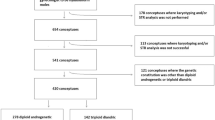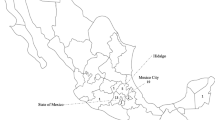Summary
Restriction fragment length polymorphisms identified with three locus-specific minisatellite probes and banding patterns with Y chromosome-specific probes have been examined in 39 cases of complete hydatidiform mole (CHM) and the parents. All 39 cases were shown to be androgenetic. Of the 39 cases, 8 were identified as heterozygous CHM using the minisatellite probes. Estimates for the total number of heterozygous CHM in the series ranged from 23%–29%, higher than previously reported. Of the eight identified heterozygous CHM, six had Y chromosome-specific sequences whereas two were female; this is not significantly different from the 2:1 ratio expected. The low frequency of 46,XX heterozygous CHM in the literature may reflect difficulties in distinguishing them from 46,XX homozygous CHM. Examination of RFLPs with a small panel of locus-specific minisatellite probes provides a powerful method of classifying hydatidiform mole, enabling the rare heterozygous 46,XX CHM to be accurately identified.
Similar content being viewed by others
References
Bishop C, Guellaen G, Geldwerth D, Fellous M, Weissenbach J (1984) Extensive sequence homologies between Y and other human chromosomes. J Mol Biol 173:403–417
Davis JR, Surwit EA, Perada J, Fortier KJ (1984) Sex assignment in gestational trophoblastic neoplasia. Am J Obstet Gynecol 148:722–725
Edwards JH (1988) Familiarity, recessivity and germline mosaicism. Ann Hum Genet 53:33–47
Edwards YH, Jeremiah SJ, McMillan SL, Povey S, Fisher RA, Lawler SD (1984) Complete hydatidiform moles combine maternal mitochondria with a paternal nuclear genome. Ann Hum Genet 48:119–127
Feinberg AP, Vogelstein B (1984) A technique for radiolabelling DNA restriction endonuclease fragments to high specific activity. Anal Biochem 137:266–267
Fisher RA, Lawler SD (1984) Heterozygous complete hydatidiform moles: do they have a worse prognosis than homozygous complete moles? Lancet II:51
Fisher RA, Sheppard DM, Lawler SD (1984) Two patients with complete hydatidiform mole with 46,XY karyotype. Br J Obstet Gynaecol 91:690–693
Fisher RA, Povey S, Lawler SD, Martin CA, Abeliovich D (1987) The human chorionic gonadotropin alpha subunit gene in gestational trophoblastic disease. I. Restriction fragment length polymorphisms in hydatidiform moles. Dis Markers 5:237–245
Hoshina M, Boothby MR, Hussa RD, Patillo RA, Camel HM, Boime I (1984) Segregation patterns of polymorphic restriction sites of the gene encoding the α subunit of human chorionic gonadotropin in trophoblastic disease. Proc Natl Acad Sci USA 81:2504–2507
Ichinoe K (1986) Mechanisms of origin of hydatidiform mole and its propensity to malignancy. In: Ichinoe K (ed) Trophoblastic diseases. Igaku-Shoin, Tokyo New York, pp 3–15
Jacobs PA, Wilson CM, Sprenkle JA, Rosenshein NB, Migeon B (1980) Mechanism of origin of complete hydatidiform moles. Nature 286:714–716
Jacobs PA, Szulman AE, Funkhouser J, Matsuura JS, Wilson CC (1982) Human triploidy: relationship between parental origin of the additional haploid complement and development of partial hydatidiform mole. Ann Hum Genet 46:223–231
Jeffreys AJ, Royle NJ, Wilson V, Wong Z (1988) Spontaneous mutation rates to new length alleles at tandem-repetitive hypervariable loci in human DNA. Nature 332:278–281
Kajii T (1980) Androgenetic origin of hydatidiform moles: its bearing on carcinogenesis. Gann Monogr Cancer Res 25:189–194
Kajii T, Ohama K (1977) Androgenetic origin of hydatidiform mole. Nature 268:633–634
Kajii T, Kurashige H, Ohama K, Uchino F (1984) XY and XX complete moles: clinical and morphologic correlations. Am J Obstet Gynecol 150:57–64
Lawler SD, Fisher RA (1986) Genetic aspects of gestational trophoblastic tumours. In: Ichinoe K (ed) Trophoblastic diseases: Igaku-Shoin, Tokyo New York, pp 23–33
Lawler SD, Fisher RA (1987) Genetic studies in hydatidiform mole with clinical correlations. Placenta 8:77–88
Lawler SD, Pickthall VJ, Fisher RA, Povey S, Evans MW, Szulman AE (1979) Genetic studies of complete and partial hydatidiform moles. Lancet II:58
Lawler SD, Fisher RA, Pickthall VJ, Povey S, Evans MW (1982a) Genetic studies on hydatidiform moles. I. The origin of partial moles. Cancet Genet Cytogenet 5:309–320
Lawler SD, Povey S, Fisher RA, Pickthall VJ (1982b) Genetic studies on hydatidiform moles. II. The origin of complete moles. Ann Hum Genet 46:209–222
Ohama K, Kajii T, Okamoto E, Fukada Y, Imaizumi K, Tsukahara M, Kobayashi K, Hagiwara K (1981) Dispermic origin of XY hydatidiform moles. Nature 29:551–552
Patillo RA, Sasaki S, Katayama KP, Roesler MI, Mattingly RF (1981) Genesis of 46,XY hydatidiform mole. Am J Obstet Gynecol 141:104–105
Royle NJ, Clarkson R, Wong Z, Jeffreys AJ (1987) Preferential localisation of hypervariable minisatellites near human telomeres. Cytogenet Cell Genet 46:685–686
Surti U (1987) Genetic concepts and techniques. In: Szulman AE, Buchsbaun HJ (eds) Gestational trophoblastic diseases. Springer, Berlin Heidelberg New York, pp 111–121
Surti U, Szulman AE (1986) Genetics of hydatidiform moles: Pittsburgh study. In: Ichinoe I (ed) Trophoblastic diseases. Igaku-Shoin, Tokyo New York, pp 17–22
Surti U, Szulman AE, O'Brien S (1979) Complete (classic) hydatidiform mole with 46,XY karyotype of paternal origin. Hum Genet 51:153–155
Surti U, Szulman AE, O'Brien S (1982) Dispermic origin and clinical outcome of three complete hydatidiform moles with 46,XY karyotype. Am J Obstet Gynecol 144:84–87
Surti U, Szulman AE, Wagner K, Leppert M, O'Brien SJ (1986) Tetraploid partial hydatidiform moles: two cases with a triple paternal contribution and a 92,XXXY karyotype. Hum Genet 189:15–21
Szulman AE, Surti U (1978) The syndromes of hydatidiform mole. I. Cytogenetic and morphologic correlations. Am J Obstet Gynecol 131:665–671
Szulman AE, Surti U (1985) Strict clinicopathological criteria in the diagnosis of partial mole: a plea renewed. Am J Obstet Gynecol 152:1107–1108
Vejerslev LO, Dissing J, Hansen HE, Poulson H (1987) Hydatidiform mole: genetic markers in diploid abortuses with macroscopic villous enlargement. Cancer Genet Cytogenet 26:143–155
Wake N, Takagi N, Sasaki M (1978) Androgenesis as a cause of hydatidiform mole. J Natl Cancer Inst 60:51–57
Wake N, Seki T, Fujita H, Okubo H, Sakai K, Okuyama K, Hayashi H, Shiina Y, Sato H, Kuroda M, Ichinoe K (1984) Malignant potential of homozygous and heterozygous complete moles. Cancer Res 44:1226–1230
Wake N, Fujino T, Hoshi S, Shinkai N, Sakai N, Sakai K, Kato H, Hashimoto M, Yasuda T, Yamada H, Ichinoe K (1987) The propensity to malignancy of dispermic heterozygous moles. Placenta 8:319–326
Wallace DC, Surti U, Adams CW, Szulman AE (1982) Complete moles have paternal chromosomes but maternal mitochondrial DNA. Hum Genet 61:145–147
Wolfe J, Darling SM, Erickson RP, Craig I, Buckle VJ, Rigby P, Willard HF, Goodfellow PN (1985) Isolation and characterisation of an alphoid centromeric repeat family from the human Y chromosome. J Mol Biol 182:477–485
Wong Z, Wilson V, Jeffreys AJ, Thein SL (1986) Cloning a selected fragment from a human DNA ‘fingerprint’: isolation of an extremely polymorphic minisatellite. Nucleic Acids Res 14:4605–4616
Wong Z, Wilson V, Patel I, Povey S, Jeffreys AJ (1987) Characterisation of a panel of highly variable minisatellites cloned from human DNA. Ann Hum Genet 51:269–288
Author information
Authors and Affiliations
Rights and permissions
About this article
Cite this article
Fisher, R.A., Povey, S., Jeffreys, A.J. et al. Frequency of heterozygous complete hydatidiform moles, estimated by locus-specific minisatellite and Y chromosome-specific probes. Hum Genet 82, 259–263 (1989). https://doi.org/10.1007/BF00291166
Received:
Revised:
Issue Date:
DOI: https://doi.org/10.1007/BF00291166




